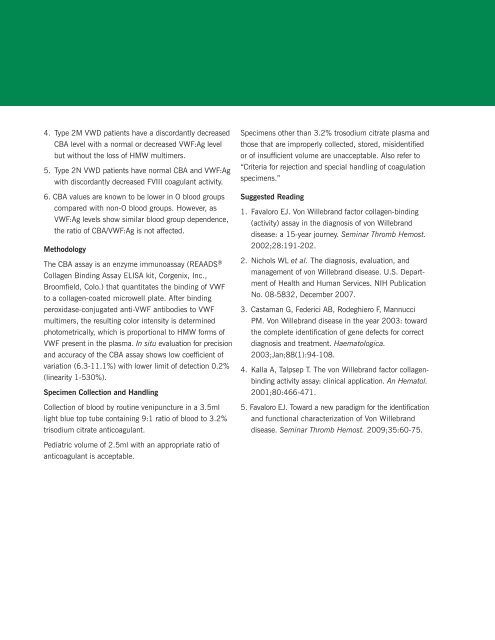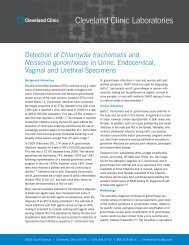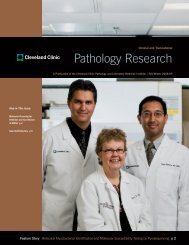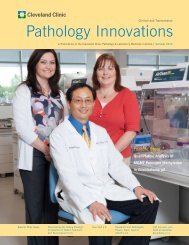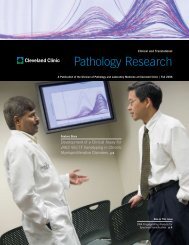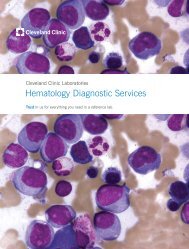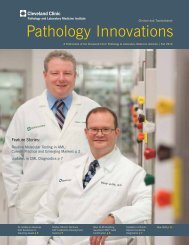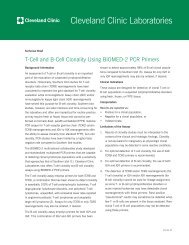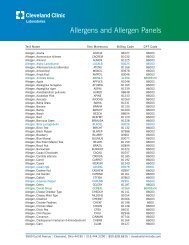Collagen Binding Activity Assay for Von Willebrand Disease
Collagen Binding Activity Assay for Von Willebrand Disease
Collagen Binding Activity Assay for Von Willebrand Disease
You also want an ePaper? Increase the reach of your titles
YUMPU automatically turns print PDFs into web optimized ePapers that Google loves.
4. Type 2M VWD patients have a discordantly decreased<br />
CBA level with a normal or decreased VWF:Ag level<br />
but without the loss of HMW multimers.<br />
5. Type 2N VWD patients have normal CBA and VWF:Ag<br />
with discordantly decreased FVIII coagulant activity.<br />
6. CBA values are known to be lower in O blood groups<br />
compared with non-O blood groups. However, as<br />
VWF:Ag levels show similar blood group dependence,<br />
the ratio of CBA/VWF:Ag is not affected.<br />
Methodology<br />
The CBA assay is an enzyme immunoassay (REAADS ®<br />
<strong>Collagen</strong> <strong>Binding</strong> <strong>Assay</strong> ELISA kit, Corgenix, Inc.,<br />
Broomfield, Colo.) that quantitates the binding of VWF<br />
to a collagen-coated microwell plate. After binding<br />
peroxidase-conjugated anti-VWF antibodies to VWF<br />
multimers, the resulting color intensity is determined<br />
photometrically, which is proportional to HMW <strong>for</strong>ms of<br />
VWF present in the plasma. In situ evaluation <strong>for</strong> precision<br />
and accuracy of the CBA assay shows low coefficient of<br />
variation (6.3-11.1%) with lower limit of detection 0.2%<br />
(linearity 1-530%).<br />
Specimen Collection and Handling<br />
Collection of blood by routine venipuncture in a 3.5ml<br />
light blue top tube containing 9:1 ratio of blood to 3.2%<br />
trisodium citrate anticoagulant.<br />
Specimens other than 3.2% trosodium citrate plasma and<br />
those that are improperly collected, stored, misidentified<br />
or of insufficient volume are unacceptable. Also refer to<br />
“Criteria <strong>for</strong> rejection and special handling of coagulation<br />
specimens.”<br />
Suggested Reading<br />
1. Favaloro EJ. <strong>Von</strong> <strong>Willebrand</strong> factor collagen-binding<br />
(activity) assay in the diagnosis of von <strong>Willebrand</strong><br />
disease: a 15-year journey. Seminar Thromb Hemost.<br />
2002;28:191-202.<br />
2. Nichols WL et al. The diagnosis, evaluation, and<br />
management of von <strong>Willebrand</strong> disease. U.S. Department<br />
of Health and Human Services. NIH Publication<br />
No. 08-5832, December 2007.<br />
3. Castaman G, Federici AB, Rodeghiero F, Mannucci<br />
PM. <strong>Von</strong> <strong>Willebrand</strong> disease in the year 2003: toward<br />
the complete identification of gene defects <strong>for</strong> correct<br />
diagnosis and treatment. Haematologica.<br />
2003;Jan;88(1):94-108.<br />
4. Kalla A, Talpsep T. The von <strong>Willebrand</strong> factor collagenbinding<br />
activity assay: clinical application. An Hematol.<br />
2001;80:466-471.<br />
5. Favaloro EJ. Toward a new paradigm <strong>for</strong> the identification<br />
and functional characterization of <strong>Von</strong> <strong>Willebrand</strong><br />
disease. Seminar Thromb Hemost. 2009;35:60-75.<br />
Pediatric volume of 2.5ml with an appropriate ratio of<br />
anticoagulant is acceptable.


